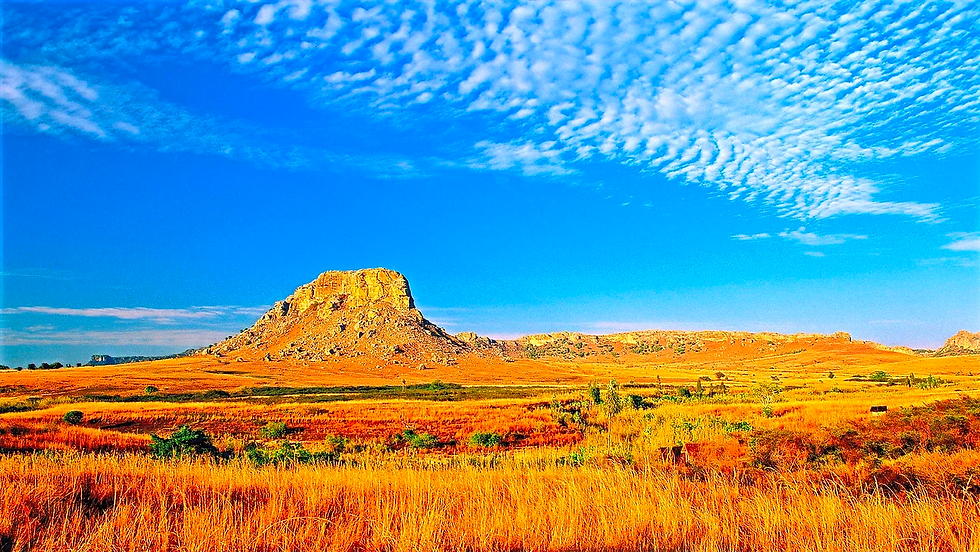“Africa is mystic; it is a sweltering inferno; it is a photographer’s paradise, a hunter’s Valhalla, an escapist’s Utopia. It is what you will, and it withstands all interpretations. It is the last vestige of a dead world or the cradle of a shiny new one. To a lot of people, as to myself, it is just home.”
~ Beryl Markham ~

TONGA SOA - BIENVENUE - WELCOME IN MADAGASCAR
Madagascar is an island on the African continent and located in the Indian Ocean to the east of Mozambique and Tanzania. It is the biggest island in the Indian Ocean and is famous for its unique wildlife and biodiversity, with a beautiful nature, white sand beaches, stunning rainforest, famous baobabs and delicious local food, Madagascar offers an unforgettable, once-in-a lifetime experience.

Madagascar doesn’t have any traditional safaris, however, does have plenty of wildlife including lemurs, chameleons, red owls, reptiles and marine life (whales, whale sharks). It also has amazing food, wonderful scenery and friendly people. The two national animals of Madagascar are the zebu and the ring-tailed lemur.



Interesting facts about Madagascar:
1. Madagascar is called Madagasikara or simply Mada in the Malagasy language. The name Madagascar goes back to explorer Marco Polo who first reported the island.
2. The capital city of Madagascar is Antananarivo, also commonly referred to as Tana. Antananarivo is the country's largest city with more than 3.6 million people.
3. The currency of Madagascar is called Malagasy Ariary, 1 Malagasy Ariary equals to 0,00023$.
4. The best time to travel to Madagascar is from September to October as the weather is a little warmer and the lemurs are more active. Travelling in Madagascar during rainy season (November-December) can be challenging but it’s such an adventure.

5. Antananarivo is situated at 1,280 m above sea level and the historic centre with the Queen's palace is located on Analamanga hill. There are 12 hills surrounding the capital city. The 'lower town' houses the commercial districts and is surrounded by extensive rice fields.
6. Madagascar was a French colony from 1897 until 1968 and then gained full independence from France on 26 June 1960. The Malagasy celebrate their country's independence annually on this day.

7.The country is also known as the "Great Red Island" for its iron-rich red soil.

8. The highest mountain in Madagascar is the Maromokotro, also known as Mount Tsaratanana, which is 2,876m high. This mountain is located in northeastern Madagascar.
9. The scenic Masoala National Park in northeastern Madagascar is the country's largest protected area which includes tropical rainforests, coastal forests and marshland, mangrove areas and a large coral reef.
10. Madagascars forests have been destroyed so much by human activity over the last centuries that only about 10% of the original forests remain.

11. Famous baobab alley in western Madagascar, near Morondava, is home to six of the eight species of baobab that are found in Madagascar only. Some of the baobabs in this alley are up to 800 years old. The baobab tree is called reniala in the Malagasy language.


12.The Ravenalla traveller palm tree is the national tree of Madagascar. This palm tree is shown on the Malagasy coins and on the logo of Air Madagascar.


13. The Toliara Colar Reef in eastern Madagascar is one of the largest coral reef areas in the world. It is also one of the most endangered reef systems in the world.
Interesting facts about people:
14. There are 18 main ethnic groups in Madagascar among them the Merina, Betsileo, Betsimisaraka, Tshimihety and the Sakalava. The largest group are the Merinas who mainly live in the centre of the country around the capital city. About a quarter of the population belong to the Merina ethnic group.

15. Madagascar is home to about 27 million people and the majority of the population (60%) are young people under 25 years of age! Almost 40% of the Malagasy are children under 14 years. This means there are large families and lots of poverty. 70% of the Malagasy live below the poverty line and have less than US$ 1.90 per day. Only 75% of the population can read or write.



16. Malagasy is the official and most commonly spoken language in Madagascar. French is also an official language and an important language in business.
17. The masonjoany is a face mask or face painting prepared from sandalwood powder and is used to protect the skin from the sun. Girls and women of the Sakalava people also often show beautifully painted faces and traditional clothes to proclaim their belonging to this ethnic group.

18. Among the most common and delicious traditional Malagasy dishes are Romazava, a stew which can be prepared with zebu, fish or chicken, Ravitoto, which is pork meat cooked in chopped cassava leaves and Mofogasy, a rice flour pancake. (Traditional Malagasy meal: Mofogasy rice cakes and ravitoto)


Facts about Madagascar - Animals:
19. The national animal of Madagascar is the zebu. Zebus are used as transport animals and raised for their meat and horns. The horns are used as tools and traditionally for tombs decorations.


20. There are 101 species of lemurs in the world, all of them living only in Madagascar. Lemurs are the world's most endangered mammals. 90% of the lemur species might even become extinct within the next 20 years if the rare primates will not be better protected.


Facts about Madagascar - Economy:
21. Rice is the main staple food in Madagascar and about 85% of all Malagasy farmers grow rice. Rice is the most exported agricultural product of Madagascar.

22. Madagascar is the world's largest vanilla export country and produces about half of the world's vanilla crops. Vanilla is the second most expensive spice after saffron because it is very labour-intensive to grow vanilla plants. Vanilla beans were introduced to Madagascar in the 19th century.
23. Madagascar has numerous natural resources such as graphite, rare earth elements, coal, salt, semiprecious stones and seafood, of course.



Fishing Village of Anakao, Madagascar

Comments